| Cas No.: | 1216722-25-6 |
| Chemical Name: | 2-[2-(4-Methoxy-pyridin-2-yl)-ethyl]-3H-imidazo[4,5-b]pyridine dihydrochloride |
| Synonyms: | BYK-191023 |
| SMILES: | C12NC(CCC3=NC=CC(OC)=C3)=NC1=CC=CN=2.[H]Cl.[H]Cl |
| Formula: | C14H16Cl2N4O |
| M.Wt: | 327.209 |
| Purity: | >98% |
| Sotrage: | 2 years -20°C Powder, 2 weeks 4°C in DMSO, 6 months -80°C in DMSO |
| Description: | BYK191023 dihydrochloride (BYK-191023) is a potent, highly selective inhibitor of inducible nitric-oxide synthase (iNOS) with IC50 of 86 nM, >20-fold selectivity over nNOS and eNOS (IC50=17 and 162 uM); exhibits an affinity for iNOS, nNOS, and eNOS of 450 nM, 30 uM, and >500 uM, respectively; inhibits cellular nitrate/nitrite synthesis in RAW, rat mesangium, and human embryonic kidney 293 cells with IC50 values 40- to 100-fold higher than at the isolated enzyme; dose-dependently suppresses the LPS-induced increase in plasma nitrate/nitrite (NO(x)) levels with ED50 of 14.9 micromol/kg/h, partially restores normal blood pressure responses to norepinephrine and sodium nitroprusside in model of LPS-induced vascular hyporesponsiveness. |

 To enhance service speed and avoid tariff delays, we've opened a US warehouse. All US orders ship directly from our US facility.
To enhance service speed and avoid tariff delays, we've opened a US warehouse. All US orders ship directly from our US facility.




















